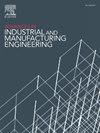3d打印摩托车座椅:复制快速原型和骑手舒适度的聚合物泡沫性能
IF 6
Q2 ENGINEERING, INDUSTRIAL
Advances in Industrial and Manufacturing Engineering
Pub Date : 2025-02-20
DOI:10.1016/j.aime.2025.100158
引用次数: 0
摘要
在最终产品投放市场之前,原型的开发需要调整生产组件,以降低成本并增加潜在修改的灵活性。虽然刚性或结构部件的制造已经建立并广泛实践,但由于最终产品依赖于所采用的特定工艺,膨胀材料的生产面临着更大的挑战。改变工艺以降低成本需要重现相同的机械行为和外观,以确保在风格和功能方面的有效性。本研究的重点是复制的行为膨胀聚氨酯泡沫,通常用于摩托车座椅填充物,使用热塑性聚氨酯(TPU)。目的是创建一个原型或定制版本的泡沫。使用切片软件设计内部随机闭孔结构,随后通过材料挤压(MEX)增材制造制作试件并进行压缩测试。结果强调了材料硬度和填充密度对力-位移曲线的重要影响。由三个参数(材料硬度、弹性模量和泡沫密度)导出的实验图说明了试样的行为,等高线表示恒定密度。这张图是一个有价值的工具,可以准确地复制所需的泡沫特性,为基于力-位移特性的材料选择提供指导。本文章由计算机程序翻译,如有差异,请以英文原文为准。
3D-printed motorcycle seats: Replicating polymer foam performance for rapid prototyping and rider comfort
The development of prototypes prior to the market launch of final products requires adapting production components to reduce costs and increase flexibility for potential modifications. While the manufacturing of rigid or structural components is well-established and widely practiced, the production of expanded materials presents significantly greater challenges due to the final product's reliance on the specific process employed. Changing the process to lower costs necessitates reproducing the same mechanical behaviour and appearance to ensure validation in terms of both style and function. This study focuses on replicating the behaviour of expanded polyurethane foam, commonly used in motorcycle seat padding, using thermoplastic polyurethane (TPU). The aim is to create a prototype or a customised version of the foam. The internal stochastic closed-cell structure is designed using slicing software, and test specimens are subsequently fabricated through Material Extrusion (MEX) additive manufacturing and subjected to compression testing. The results emphasise the critical influence of material hardness and infill density on the force-displacement curves. An experimental map, derived from three parameters (material hardness, elastic modulus, and foam density) illustrates the behaviour of the specimens, with iso-lines representing constant density. This map serves as a valuable tool for accurately replicating desired foam properties, providing guidance on material selection based on force-displacement characteristics.
求助全文
通过发布文献求助,成功后即可免费获取论文全文。
去求助
来源期刊

Advances in Industrial and Manufacturing Engineering
Engineering-Engineering (miscellaneous)
CiteScore
6.60
自引率
0.00%
发文量
31
审稿时长
18 days
 求助内容:
求助内容: 应助结果提醒方式:
应助结果提醒方式:


